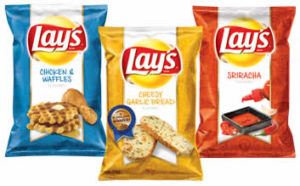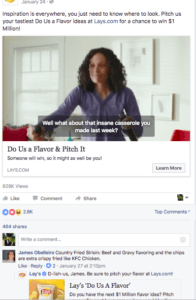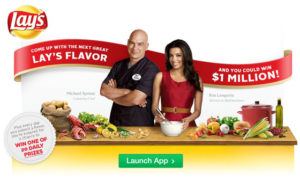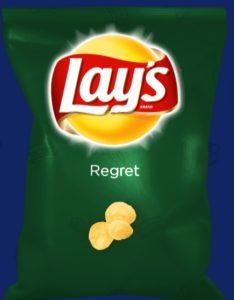Frito-Lay’s Do Us a Flavor Contest

Lay’s potato chips crowd-sources new flavors in an annual contest – but is it more marketing engine than product development innovation?
In 2012, Frito-Lay launched in the U.S. what would become a winning annual contest: the Do Us a Flavor campaign, which crowd-sourced ideas for new potato chip flavors. The company had already tested the campaign in other countries, generating a whopping 8 million submissions.
How does it work? Contestants submit flavor ideas on the Do Us a Flavor website – they choose a catchy title, up to three ingredients, create a quick pitch, and design the bag. A judging panel of experts narrows it down to three winning flavors. Then the flavors enter the product development pipeline, during which recipes are developed and tested Frito-Lay’s team. The three flavors launch in grocery stores, where fans can purchase and then vote on their favorites via Twitter, Facebook, or text message. The winner gets one million dollars or 1% of flavor’s net sales in that year – whichever is greater. The two runner-ups win $50,000 each.[1]

The cash prize is a major incentive for participants to enter the contest. But there are also other important drivers of participation. For consumers, the submission process is simple, fun, and creative, making the barriers to enter the competition very low. Individuals can browse other participants’ flavor ideas and submit multiple flavors. The notion that anyone can be a recipe developer with product on the shelves at national supermarkets – a Facebook ad suggests that the casserole you made last night can be the next winning flavor – is empowering. And the power comes full circle back to a very engaged community of social media followers; not only are the ideas crowd-sourced, but the crowd chooses the winner. In this way, Frito-Lay has created a hybrid of a lottery, game, and community.

Do Us a Flavor has created significant marketing value for Frito-Lay. The company is gaining insights into consumer preferences and behaviors firsthand and at scale (in contrast to highly curated and small traditional focus groups). Frito-Lay launched the contest due to “declining market penetration among millennials.” The contest is now engaging a younger age group that is active on social media; they use hashtags to vote for winning flavors and share their flavor creations on Facebook and Twitter in mini-campaigns. Brand awareness has increased due to the significant media buzz, events, and celebrity partnerships surrounding the contest.[2]

It can also be inferred that the contest is forcing shorter product development and time-to-market cycles. By my estimation, the entire contest – from ideation through final product launch – is ten months. The submission process lasts three months, product development and launch of the three finalist flavors occur over four months, and consumer testing lasts for three months. In contrast, the standard product development timeline for CPG firms is 16 – 22 months.[3]
At the same time, there are challenges in controlling the crowd and optimizing for performance. Users submit inappropriate and parody flavors, necessitating careful monitoring and filters; for example[4]:

While the campaign may be brilliant marketing, the performance of the winner is unclear, suggesting that the contest may not be a viable strategy for product development of the company’s next blockbuster product. Finalist flavors have received terrible reviews, with cappuccino described as “abominable”[5] and Wavy Mango Salsa as “like a chemical attack on your mouth”[6]. The 2013 winner, for example – Cheesy Garlic Bread – appears discontinued (as were winning products in other countries). How can one explain the failure of a product voted on by a million people? Perhaps a large portion of those voting had not tried the chips, and even though the flavor sounded good in theory (or at least the best of the three options), the product was not up to par. Perhaps votes are not a good indicator of purchase intent. Or perhaps the votes of enthusiastic participants are not reflective of broader tastes.
Flavor fails are only a negative, of course, if the goal is longterm sales growth. Consumers enjoy the novelty of unusual products and Lay’s enjoys the marketing buzz that accompanies them. If the contest is turns more marketing gimmick than serious, then the company risks alienating consumers with bad products or decreasing trust in the brand. However, if the company truly does view this contest as a longterm product development strategy, then I believe it should a) recognize the difference between novelty and a winning product and b) think more broadly about what consumers value beyond flavor. To develop a truly innovative crowd-sourced product, the company could source ideas on health, ingredients, form, and more.
[1] http://www.pepsico.com/live/pressrelease/lays-potato-chips-teams-up-with-eva-longoria-and-iron-chef-michael-symon-to-invi07202012
[2] https://www.forbes.com/sites/brandindex/2014/10/11/crowdsourcing-campaign-appears-to-boost-brand-perception-for-lays/#25f08072571d
[3]https://www.bcgperspectives.com/content/articles/consumer_products_go_to_market_strategy_speed_to_win/?chapter=2
[4] http://uproxx.com/webculture/best-lays-do-us-a-flavor-parodies/5/
[5] http://theconcourse.deadspin.com/lays-cappuccino-potato-chips-are-abominable-1616602575
[6] http://www.today.com/food/we-tried-lays-cappuccino-chips-so-you-dont-have-1D79934950



Interesting post! I have noticed that the idea of crowd sourcing consumer product flavors has become more prevalent and I wonder if Lays was the originator of this fad. For example, I remember Anheuser-Busch launched a similar process to enter into the craft beer market with their “Black Crown” lager. It also suffered some of the same issues as Lays with middling commercial popularity (despite positive reviews) in an over crowded space. I have often wondered whether this necessarily means the endeavor was a failure and therefore really enjoyed your point about marketing gimmick vs product development (and the relative merits of each). I wonder if this crowd sourcing trend will continue to gain popularity or companies will be dismayed by lackluster sales, especially as people begin to associate these new flavors with not-so-great reviews.
Cheesy garlic bread ftw. It seems like a lot of these campaigns have a pretty negligible impact on R&D. Wonder how much of this is truly to get ideas vs simply engaging with a customer segment that might otherwise be disengaged.